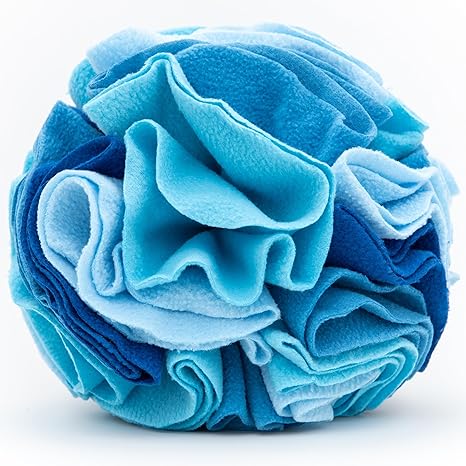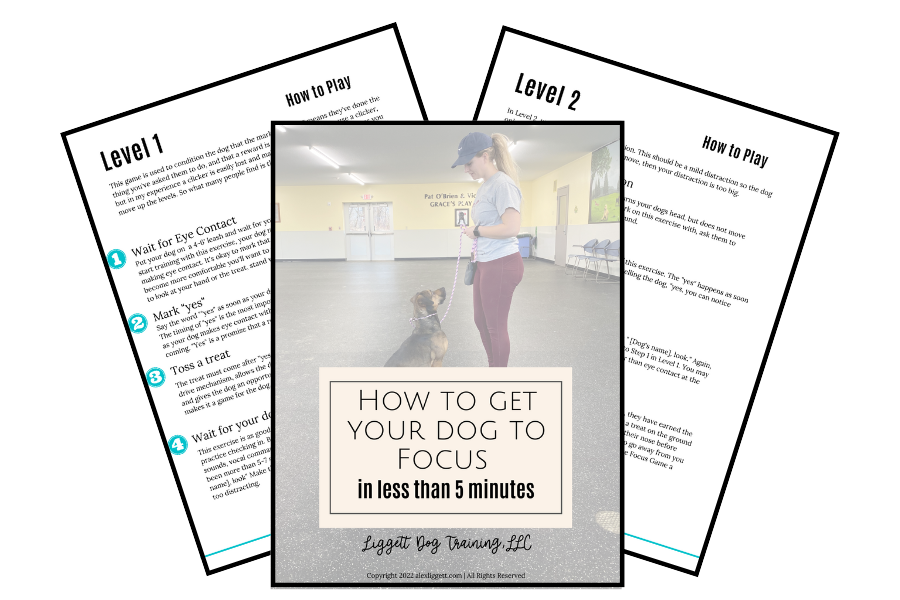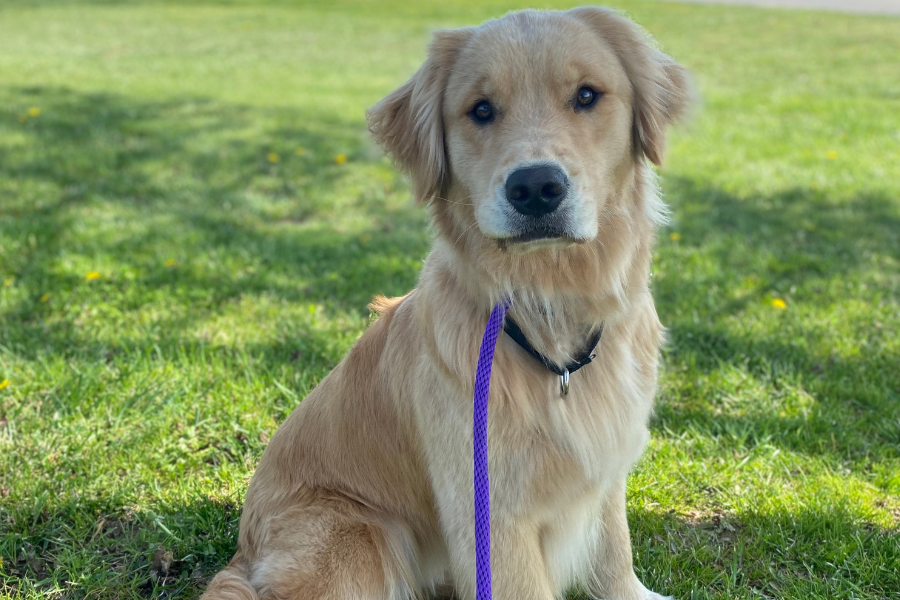
This post is all about how to keep an energetic dog calm after surgery.
Just because your dog needs to rest for 10-14 days after surgery doesn't mean that they don't get to do anything! After my high energy dog, Razz, had four masses removed I had to get creative with making sure that she didn't loose her brain during the recovery process.
Plus, some activity made it easier for her to stay calmer in the long run! In this post, I'll share 12 activities you can do with your dog to help keep them calm while they heal from their procedure.

How to Keep an Energetic Dog Calm After Surgery
Depending on your dog's surgery, their rest time maybe a few days to a few months. It's so important for your dog to stay physically calm after surgery for a minimum of 7 days.
After a soft-tissue surgery they may be prescribed rest up to 10-14 days following the surgery. While an orthopedic surgery might be a few months of rest and recovery. Consult your veterinarian for an exact rest time given your dog's procedures.
Giving your dog something to do during the recovery period will have several benefits. It gives them a sense of normalcy and comfort. It can be good to distraction from worrying about their surgery site. And, they'll have less energy to run, play and lick their surgery site.
Related:18 Simple DIY Dog Enrichment Ideas Your Dog Will Love
Dog won't relax after surgery
After your dog has surgery, they may be very anxious and needy. The anesthesia can make them nauseous and disoriented. So don't be alarmed if your dog is vocalizing, pacing or showing other signs of anxiety up to 24 hours after their procedure.
Help your dog settle down by offering them a spot to lay down and rest away from the commotion. Keep them away from stairwells or other areas that could cause them to stumble and hurt themselves.
Usually the day after surgery, dogs are back to their normal self and ready to know what activity is next! This is when it's important to keep them calm and relaxed during the healing process.
How to stop dog jumping after surgery
Related: 3 Proven Methods for How to Stop Dog Jumping Up
Playing offense is the best defense for a high energy dog who jumps up after surgery. If your dog is eager to jump and run around, let them drag a leash around the house, so you can easily redirect them quickly and easily.
If you can't keep an eye on your dog, it's probably best to crate them or limit their activity with baby gates, pens or doors.
When your dog continues to jump, it is because they are being rewarded for it. Refrain from giving your dog any vocal words like "off" or "down" or physical touch when they jump up. Most importantly, do not give them any eye contact.
These are all behaviors from humans, that can be rewarding for dogs. Remember, make the right thing fun and the wrong thing boring when training any high energy dog.
If you plan to have guests over, use your crate and your leash to help keep your dog calm.
Related: Prevent Jumping Up | My Dog Gets Overly Excited When Guests Come Over
How to entertain dog after surgery
Here's a list of all the things I've tested with my own dog to help keep her calm after surgery.
1. Sniff Walks
This one you may want to wait until a few days out from surgery depending on the type of surgery your dog had.
You know how your dog always wants to sniff things on walks?? Well, now is a perfect time to allow your dog the opportunity to take their time on the walk!
Allow your dog to spend as much time as they'd like at each smell on the walk. You'll find this activity goes a long way, even if you don't cover a lot of ground.
You may just spend half an hour on just the first block around your house.
This is such a great activity for your dog's mental health as they are recovering and it's low stress!
2. Snuffle Mats and Snuffle Balls
Anything that your dog can use their nose for is going to go a much longer way than physical activity. And that goes for after they're done with recovery, too!
Getting a dog to use their nose is a tiring activity- think of it like taking a test or learning a language. These skills requires a lot of cognitive power.
Consider a snuffle mat or snuffle ball for your dog's meal times, rather than their bowl.
One of the easiest ways to slow your dog down during meals and get them to use their brain. These can take up to 30 minutes for some dogs to search the whole mat!
These can take a long time to fill, but last a long time too! Supervise your dog with these, as once they get towards the end they may try to rip it apart. It takes dogs a little longer to get through this than the snuffle mat though!
How do you keep a dog calm?
3. Kongs
While they don't offer a lot of brain power, they can last a long time. Especially if you freeze them and through some kibble in there.
Kongs aren't just made for peanut butter either. Try any of these recipes to make your kong a little more healthy. This is especially important to consider when your dog isn't getting the same physical activity they usually do.
A classic dog toy for enrichment. Whatever you fill it with, don't forget to freeze it so it lasts a lot longer!
4. Bully Sticks
Now is the best time to engage your dog's chewing habits!
Set them up with a quality bully stick, beef tendon or even a bone from the grocery store. Be careful with grocery store bones from the meat section- they can be messy and are great for outside activities.
Not all bully sticks are equal, and depending on your dog they may go through a bully stick in 10-30 minutes, or up to a few days.
Our dogs love these- but despite what the packaging says, they are not odor free. So be mindful where you give these treats! There's also a 12" size (which is usually what I give my dogs since they last longer)
For dogs who tend to bite off a little more than they can chew, there's a bully stick holder so that your dog can't swallow that last piece of hard candy.
Can't keep a dog calm after spay
5. Play the Focus Game
This could be your dog's new favorite game. Plus, they don't even realize that your training them at the same time.
Start playing the game inside, then you can move to more challenging environments as your dog gets better at it.
6. Leash Training
Related: Loose Leash Dog Training in 4 Simple Steps
Depending on your dog's leash manners and level of restriction, this is a great activity for the end of the recovery period.
During their recovery period, you can teach your dog how to give to pressure, rather than pull against a tight leash using these tips.
You might cover a lot of ground, but this is an exercise that can be done in your hallway or your driveway!
Related: How to Use a Slip Leash
7. Sit on the dog
This is a great training exercise for you and your dog to do and it requires very little physical activity.
Sit on the dog is one of the most important training activities you can possibly do (and one of the easiest!)
Can't keep dog calm after surgery
8. Take your dog to new places
Towards the end of your dog's recovery, take them somewhere new! Plus, you can work on playing the Focus Game or the Sit on the Dog activity.
Home depot, Lowe's, Joannes or any other home improvement store usually allows dogs. It's probably best to avoid pet stores as there's an increased chance you may run into other dogs.
9. Hide their food
There are so many opportunities for your dog to use their nose! Hide their food so they have to sniff it out. You can take the whole bowl, or hide kibble around the house.
10. Teach a place command
This kind of training teaches your dog impulse control and to relax. This command is useful when you have guests over, or your dog is barking at the mail man.
When taught correctly, your dog could do place for up to 90 minutes!
Related: Place Dog Command | The Most Under-Rated, Under-Taught Obedience Command
11. Give your dog a massage
While being mindful of the surgery site, massage your dog and snuggle up with them!
Spend some quality time on the couch or in the dog bed. Your dog probably felt like they went through some sort of alien abduction, so it's okay to pamper them a little.
If you're really interested, you can even take a class with the option to earn a certification in canine massage.
Alternatives to Dog Cone
12. If possible, ditch the cone of shame
It is so, so important to keep your dog calm after surgery.
As a former veterinary technician, I have seen so many dogs become instantly more agitated and anxious as soon as the cone goes on. This does not promote recovery.
The cone of shame can give your dog anxiety and cause more movement and stress. Plus, it can be irritating on their skin. A cone can cause damage around the house since a dog doesn't always immediately understand how they are suddenly much wider than usual.
In my opinion, it is usually way less stressful to go without the cone IF you're able to.
If you can use another form of prevention, ditch the cone. You can use a baby or toddler onsie, human shorts, t-shirts, a donut, dog recovery suit, or dog pajamas.
Alternatively, you can even just close supervision to keep your dog from licking at their surgery site.
When I brought my dog home, she didn't have anything on if I was home. I made sure she was in the same room as me at all times, and when I left, I put her in shorts and a t-shirt with hair ties to help hold everything in place.
Medication to Keep Dog Calm After Surgery
If your dog is hyper, veterinarians can prescribe something to help sedate your dog. In most cases, this is an SSRI called Trazodone. This is usually prescribed on an as needed basis.
Anti-anxiety medications like Prozac (fluoxetine) can take weeks to kick in, so they are usually not recommended for an as needed basis.
Don't be afraid to ask your veterinarian about something short-term to help keep your dog calm.
Healing is important and healing correctly can help prevent more damage, scarring, long-term complications or a longer healing time.
Benadryl to keep dog calm after surgery
Do not give benadryl to your dog with the intent for it to calm them down.
Benadryl does not work the same way with dogs that it works with people. Diphenhydramine, otherwise known as benadryl, is an antihistamine, but does not make dogs sleepy like they make people sleepy.
Your vet may prescribe Benadryl if your dog had a Mast Cell Tumor removed to help with the histamines. However, don't expect it to keep them calm.
Instead, try asking your veterinarian about a short-term sedative you can use to decrease their energy level.
Is there an idea we missed? Let us know! Send us an email at alex@alexliggett.com









